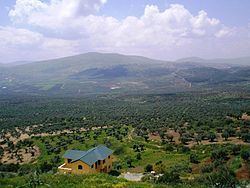Name meaning The Caves Local time Saturday 12:19 AM | District Northern Area 19.8 km² | |
 | ||
Weather 11°C, Wind N at 18 km/h, 68% Humidity | ||
Maghar (Arabic: المغار, Hebrew: מַעָ'ר, also al-Maghar or Mghar; lit. the cave) is an Arab town in Israel's Northern District with an area of 19,810 dunams. Maghar was given the status of a local council in 1956. In 2015 it had a population of 21,650.
Contents
- Map of Maghar Israel
- Beppe costa 13 nisan international poetry festival maghar israel
- Antiquity
- Ottoman era
- British Mandate
- State of Israel
- Demographics
- Education and culture
- Notable residents
- References
Map of Maghar, Israel
Beppe costa 13 nisan international poetry festival maghar israel
Antiquity
Pottery remains from the early Roman period have been found here, together with architectural remains and pottery fragments from the Late Roman period. A quarry has also been excavated.
The village's name comes from the Arabic word for "the caves".
Ottoman era
In 1596 the village appeared in the Ottoman tax registers as Magar Hazur, part of the nahiya of Tabariyya in the Liwa of Safad. It had an entirely Muslim population consisting of 169 households and 17 bachelors. Taxes were paid on wheat, barley, olive trees, goats and/or beehives, and a press for olives or grapes, and in 1555 on silk spinning.
In 1875 French explorer Victor Guérin found the village, which he called el-Mehar, to be a large one with 1200 inhabitants. It was divided into three quarters, with Muslim, Christian and Druse inhabitants. In 1881, the Palestine Exploration Fund's Survey of Western Palestine described El Mughar as a "large stone-built village, containing about 1,100 Moslems, Druses, and Christians, situated on the slope of the hill, with extensive olive-groves to the south and west; a large spring and birkeh gives a good supply of water."
British Mandate
In the 1922 census of Palestine, conducted by the British Mandate authorities, Mughar wa Mansura had a total population of 1377. Of these, 265 were Muslim, 676 Druze and 436 Christians. All the Christians were Roman Catholic. In the 1931 census the population of Maghar, together with Al-Mansura, was a total of 1733, in 373 inhabited houses. Of these, 307 were Muslim, 549 Christians, and 877 Druze.
In 1945 the population of Maghar, together with Al-Mansura, was 2,140; 90 Muslims, 800 Christians and 1,250 others. who owned 55,583 dunams of land according to an official land and population survey. 7,864 dunams were plantations and irrigable land, 18,352 for cereals, while 55 dunams were built-up (urban) land.
State of Israel
During Operation Hiram, 29–31 October 1948, the town surrendered to the advancing Israeli army. Many of the inhabitants fled north but some stayed and were not expelled by the Israeli soldiers. The town remained under Martial Law until 1966.
During the 2006 Israel-Lebanon conflict, two residents of Maghar were killed and several wounded in Hezbollah rocket and cluster bomb attacks. On July 25, Doua Abbas, 15, was killed by a rocket that hit her house. On August 4, Manal Azzam, a 27-year-old mother of two, was killed, and two other residents were seriously wounded when a rocket hit their apartment building.
Demographics
The majority of residents are Druze (57%), with Arab Christians (23%) and Muslims (20%). Many of the Druze residents serve in the IDF and Israel Police.
Education and culture
In August 2003, the Israel Circus School established a joint Jewish-Arab "Children’s Circus" together with its partner, Circus Maghar. A group of 20 Jewish and Arab children trained for the circus. In addition to local performances, the circus school toured Cyprus, giving workshops and performances for Christian and Muslim schools and community centers.
